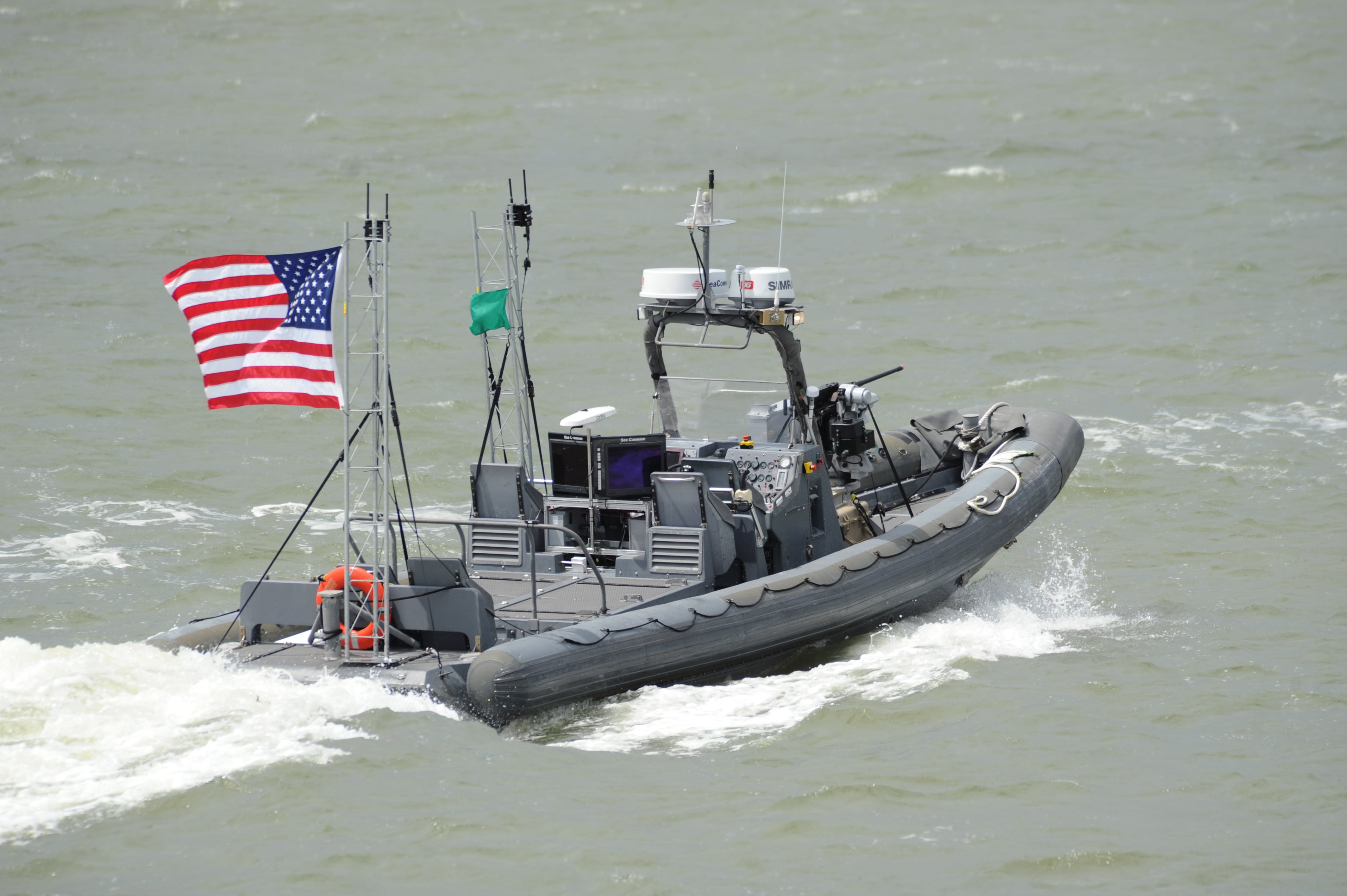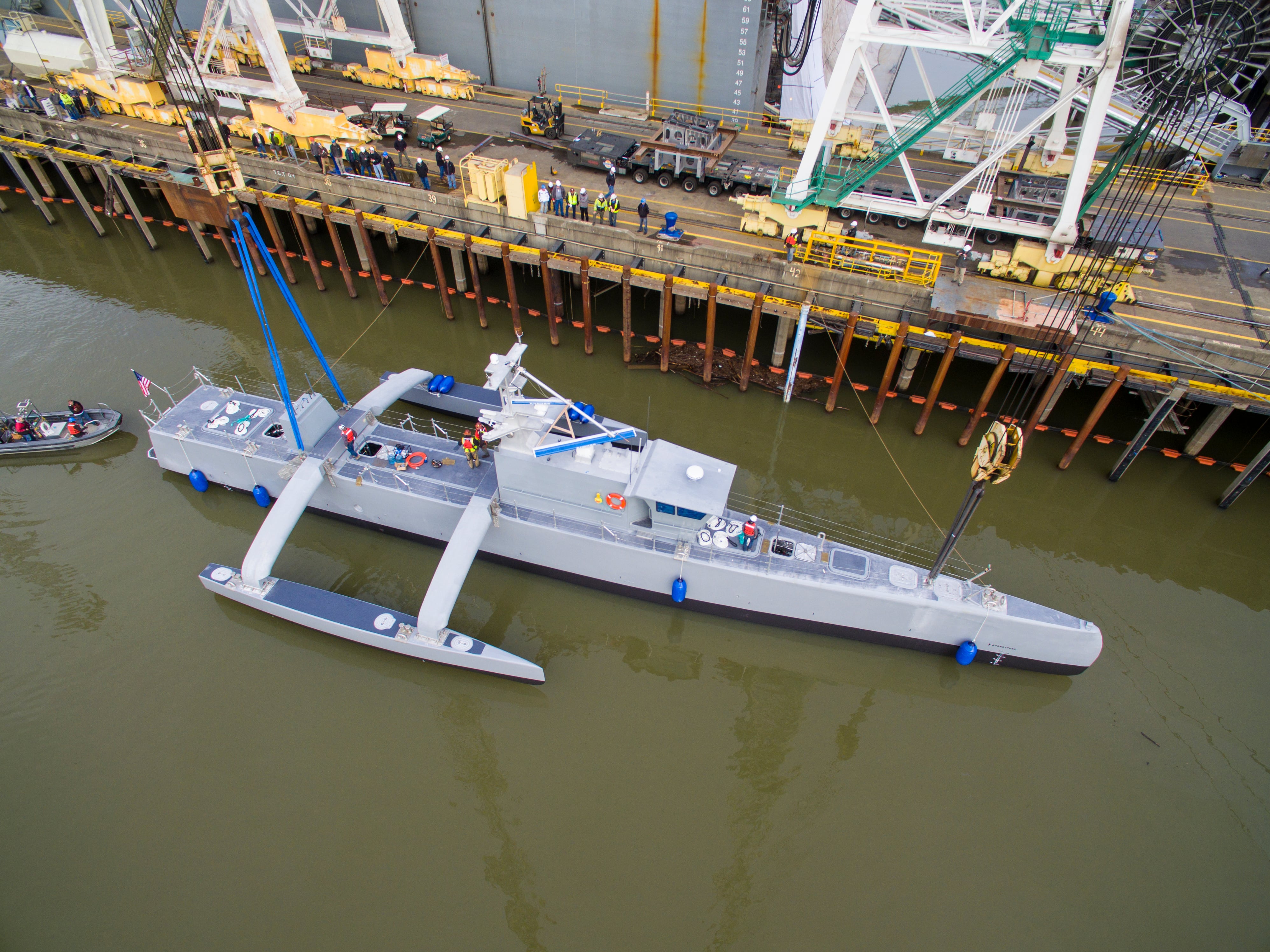2016 is shaping up to be the year of the robot warship.
Two trends are converging: the development of highly autonomous unmanned surface ships that can function individually, and the development of swarm control systems that enable flotillas of unmanned ships to operate as a cohesive formation, again with minimal human intervention.
The first fruits of these trends occurred in April in Portland, Oregon, when the Defense Advanced Research Projects Agency and the Navy christened a large robotic submarine hunter called the . The DARPA's Anti-Submarine Warfare Continuous Trail Unmanned Vessel. (ACTUV) is a 132-foot-long unmanned surface vessel designed to detect and track ultra-quiet diesel submarines.
In September comes a demonstration of Unmanned Surface Vessel Swarm, an Office of Naval Research project to create groups of small boats that can function as a team. The first demonstration was held in August 2014 on the James River in Virginia when five small, unmanned boats showcased the Control Architecture for Robotic Agent Command and Sensing (CARACaS) system. The CARACaS-controlled boats escorted a high-value naval target and swarmed any remote-controlled "enemy" vessels that approached the convoy.

An unmanned 11-meter rigid hulled inflatable boat from Naval Surface Warfare Center Carderock operates autonomously during an Office of Naval Research-sponsored demonstration of swarm boat technology held on the James River in Newport News, Va., in August 2014.
Photo Credit: John Williams/Navy
This time, the boats will be capable of a lot more, according to Robert Brizzolare, an experimental physicist who is ONR's program officer for USV development. In 2014, the swarm boats had autonomy, but not coordination. "Each CARACaS on each boat made its own decisions in a vacuum," Brizzolare recalled.
Each USV knew its position and the position of the other boats, so they could maintain their assigned stations relative to the ship under escort. "But if one USV had to break off to investigate something, the other boats were not smart enough at that time to be able to compensate in their positions," Brizzolare said.
More sophisticated CARACaS algorithms will enable the boats in the second demonstration to "negotiate" over which boats will perform what task. "For example, if there's a threat vessel in the area, the boats can collectively decide which of the USVs is going to investigate it," Brizzolare said.
Equally important is a new collaborative ability to plan routes.
"That allows them to take into account each other's position, so they don't get too close to each other and risk a collision," Brizzolare said. "They can also maintain better formations. If they're escorting a high-value unit, and one of the USVs has to go over and investigate a questionable vessel, the other USVs can adjust their routes to compensate."
These new capabilities were made by possible by improved algorithms in CARACaS, which were was developed by NASA's Jet Propulsion Laboratory based on NASA's work on the Mars rover and other space projects. For example, the planning and scheduling components of CARACaS come from NASA.
Devising new algorithms was the most difficult part of the second demonstration, in part because so much depends on the quality of the situational awareness data.
The most difficult part of the second demonstration was devising new algorithms, in part because so much depends on the quality of the situational awareness data.
"If the boat's perception engine [sensors and algorithms] does not detect the presence of other vessels, that's a problem," Brizzolare said. "There could be a collision, or the vessel that isn't detected could be the vessel we want to inspect to see if it's a threat."
On the other hand, aAs with any automated system that responds to sensor data, filtering out false alarms is also a challenge.
The USVs are equipped with commercial-off-the-shelf maritime radar as well as cameras. Rather than monocular cameras, tThe vessels have stereo cameras — based on those used in the Mars rover — that are better suited for determining the range to an object. However, The problem is that stereo cameras have shorter ranges than monocular cameras, but USV Swarm researchers were able to have extended it the range, according to Brizzolare.
In turn, cCameras for an automated ship require automated imagery analysis so that the computers can interpret the visual data. Brizzolare said because imagery analysis is computationally intensive, the challenge there was there the ability to be able to analyze the camera images fast enough to enable the USV to avoid a collision.
The boats themselves are standard Navy small craft, surplus 7- and 11-meter rigid hull inflatable boats. Human control — or more accurately, human supervision — was exercised in 2014 through a desktop control unit. The second test will feature a tablet-based station.
The ability to operate in low- or no-bandwidth environments has become obligatory for many military systems, but it is especially crucial for unmanned craft that must be capable of functioning without human intervention. Depending on the circumstances, USV Swarm can operate under "sparse supervisory control" with no human supervision. Their responses to loss of communications would need to be preset so that they might, for example, hold position or return to base. They would need fresh instructions if, say, the mission changed. But otherwise, "as long as the information they have is current, they can keep going without an external connection to the outside world for some period of time," said Brizzolare. "If there is nothing else out on the water, the boats can keep going. If there is a lot of traffic or complexity, we would want more human supervision."

The DARPA Anti-Submarine Warfare Continuous Trail Unmanned Vessel, or ACTUV, was christened "Sea Hunter" in April 2016 in Portland, Oregon.
Photo Credit: DARPA
At first glance, ACTUV and USV Swarm are dissimilar projects. ACTUV is a relatively large, unmanned vessel that can operate as a solo ship. USV Swarm is all about multiple boats. ACTUV is designed for the open ocean while USV Swarm is designed for operating on rivers where traffic is dense and ships are in close proximity to each other. Each ACTUV will cost $20 million. A small Navy boat can be converted into a swarm craft for as little as $50,000 apiece.
Yet the two projects are really two sides of the same coin. "There is no reason why this CARACaS swarm concept could not be applied to a group of ACTUV-sized vessels," Brizzolare said. "Then you get the benefits of the range of that size of vessel, the seakeeping ability and the payload capacity."
The trick, he said, would be to integrate USV Swarm's group behavior algorithms into the ACTUV control software.
During ACTUV's christening, Deputy Secretary of Defense Robert Work spoke glowingly of swarms of ACTUVs.
"Imagine anti-submarine warfare pickets," he said. "Imagine anti-submarine warfare wolf packs. Imagine mine warfare flotillas, distributed surface warfare action groups, deception vessels, electronic warfare vessels."
Neither ACTUV nor USV Swarm is armed. The creators of both are focusing more on developing autonomous ships than turning them into weapons platforms. But there is no reason why they can't be armed someday.
Ultimately, what is significant about the Navy's robotic ships isn't the ships, but rather the robotics. USV Swarm and ACTUV are, at heart, concepts that are about controlling ships rather than building ships. Their essence is the computer algorithms that enable vessels to function autonomously and cooperatively with a minimum of human guidance. Taken to its logical extreme, the path the Navy has embarked on suggests that if you can develop a sufficiently sophisticated control system, then big ship or small ship, the size of the platform doesn't matter. Dismaying as that prospect may sound to old salts and anybody else wary of an inhuman future, it does suggest that a battle fleet composed primarily of robots could become reality someday.








